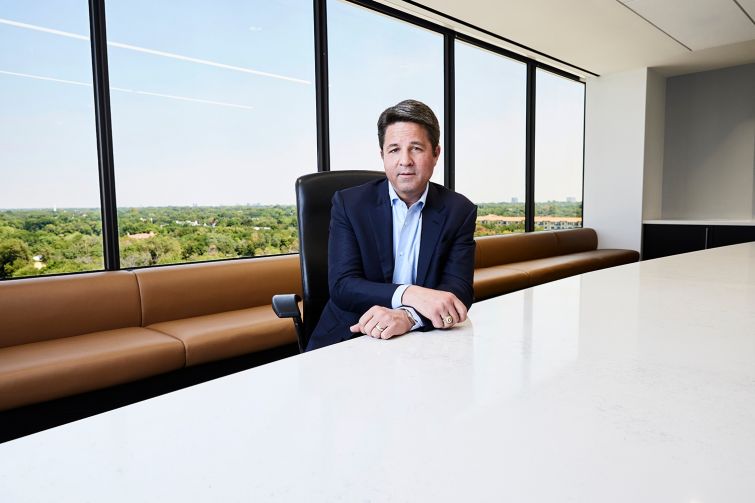Brannon Hamblen Talks Bank OZK’s CRE Lending Growth
By Andrew Coen September 6, 2023 8:00 am
reprints
Growing up on a farm in Kaufman, Texas, southeast of Dallas, Bank OZK (OZK) President Brannon Hamblen took on many responsibilities at a young age, managing animals, gardens and pecan trees.
The daily tasks Hamblen became familiar with now serve as a relaxing escape during a volatile time for commercial real estate lending. Hamblen, who became president of Little Rock, Ark.-based Bank OZK in July 2021, enjoys visiting a farm in central Texas that he acquired from his father in 2018 as a distraction from myriad challenges confronting the commercial real estate space.
“It was fun and sometimes hard work growing up, but it’s relaxing for me today,” said Hamblen, who first arrived at Bank OZK in July 2008, just before the Global Financial Crisis (GFC).
Hamblen, who grew up hunting with his dad starting at age 3, is now angling for CRE loans across a number of property sectors to help maintain Bank OZK’s reputation as a top construction lender. The bank defied the odds in 2022 when it nearly doubled its lending volume from the year prior with $13.82 billion in origination volume. Now, in 2023, Bank OZK is continuing to bring deals across the finish line despite a continued rising interest rate environment.
Prior to ascending to his current role, Hamblen spent nearly four years as president and chief operating officer for Bank OZK’s real estate specialities group (RESG). Today he works out of OZK’s Dallas office.
He spoke with Commercial Observer toward the end of August about Bank OZK’s rise from regional bank to leading national lender, the demand for construction loans amid higher interest rates, and the prospects for office conversion projects.
The interview has been edited for length and clarity.
Commercial Observer: You studied agricultural economics at Texas A&M University and then earned a bacherlor’s degree in land economics and real estate at the school. When you were exploring these subjects, was a career in commercial real estate finance on the radar?
Brannon Hamblen: Going into college, honestly, it wasn’t. I grew up in a small town in a pretty rural setting, so I definitely enjoyed real estate in my formative years, but it was way different than the type of real estate that we’re financing today. As I was looking at going to school and what I was going to do, my dad said, “Real estate has always been good to me,” and, with that single sentence, I focused on it.
At the time at A&M, most real estate-related courses were in the agricultural economics program, so I did not dream that I would touch some of the deals that I’m touching today when I started that program. I jumped in, and I followed it up with the [university’s] master’s in land economics and real estate program. I met the right people and landed my first job in real estate consulting, and the rest is history.
Jumping ahead in your career, when you first arrived at Bank OZK in July 2008 it was just before the GFC. What was that period like?
It looks like remarkably bad timing, doesn’t it? But from where I sit it was really great timing to join a great company. I’d worked in a prior life for the guy that created the real estate specialties group (RESG) here in Dallas, so I had an inside track that painted a picture I knew I could trust about the organization. I’m really grateful I made the move when I did, because I was able to be on the ground floor of building a line of business within the bank that we’re obviously very proud of today.
It was a tough time, but the bank had been built to be sustainable and to be in the market lending every day. That was the case during the GFC, through 2020, 2021 and the like. It was a great honor to be there to help build that and be ready to capitalize on the opportunities that arose coming out of that time period.
What was it like to be at Bank OZK at a time of significant growth, where it rose from a regional bank to become a national lender?
I just had my 15th anniversary with the bank on July 21 so I’ve been here a minute and have seen some things change. I’ve seen the organization mature and pass a lot of milestones and it’s been an absolute privilege to be a part of it. The day I joined the bank, the real estate specialities group had 67 loans in its portfolio and, probably, call it $650 million, give or take, in total committed dollars. On June 30 of this year, the real estate specialties group had almost $32 billion in total commitments on 342 loans.
So, to say it’s been a significant growth is probably an understatement. But, as impressive as that is, it’s no more impressive than the rest of the organization and the engine that generates the deposits that fund all of our real estate loans.
Our chairman and CEO, George Gleason, has just built a phenomenal organization with an extremely impressive record of consistent asset quality and profitability, so the bank was always positioned to grow and, obviously, grow we did. We built a business that really is just founded on working hard, working smart and being creative for all of our real estate developer borrowers, the number of which has obviously increased significantly over the years as well. Speed and certainty was the standard we lived by, and a lot of us in the group have backgrounds outside of banking related to real estate law, acquisitions, asset management and development. So it gave us an advantage in understanding risk, how to mitigate it and how to originate loans at an attractive leverage point for an attractive yield to a very satisfied customer base.
The GFC really gave us a tremendous advantage in that so many lenders were in a more defensive posture. We had dry powder, we were hungry, and year by year more developers were finding us from markets around the country.
I remember we originated $110 million in 2010 in RESG, and then we basically doubled that output annually until we hit $9.1 billion in 2017, and then five years later we originated in RESG $13.8 billion in 2022. It’s a great story, but it’s not the whole story. The bank itself is certainly great at commercial real estate lending, but it’s diversified significantly beyond that in other lines of business, and it’s had a tremendous performance through a pretty uncertain time around growing its deposit base. So it’s really from top to bottom and team to team a great organization and a great story.
Since your arrival, the bank has really begun to focus on life sciences. What sparked this interest, well before demand for the sector really picked up?
I wish there was some sort of secret sauce in the answer there, but it’s really simple. Our platform has been built on making low-leverage loans to best-in-class sponsorship on best-in-class products in best-in-class markets, and this really came out of just pursuing that strategy.
The first life science deal we did was in Boston in 2019. The guys were working on expanding our presence in Boston and, in the process of doing that, the guys unearthed an opportunity with a group with a really great track record; and they dug into the deal, made the loan, and we took it from there. Life science definitely didn’t get the airtime when we did that first loan that it does today. We were just focused on the basics of our business, and that’s how that evolved.
What is the demand at this point for life sciences construction loans now that we’re more than three years past the height of the pandemic?
It’s clearly more muted than the past couple of years. It’s well documented that there is a lot of product under construction now and will be delivering in the near term, and leasing has moderated from what was really a blistering pace coming out of the pandemic. So equity has slowed down a bit, and that really goes all the way back up to the venture capital appetite. But absorption continues, and it’s not that it’s evaporated by any stretch. It’s just closer to a longer-term average and, as that occurs, markets will level, and in the long term I think that will be a solid sector with demonstrated demand for new product.
How have rising interest rates impacted your construction lending business?
It is, at the very least, taking the foot off the accelerator, if not putting some brakes on, but it’s all relative. I mentioned earlier that we did $13.8 billion of originations in 2022, which was a record for us, so we’ll still have a good year.
But it’s not just the volume of deals that have pulled back, it’s the speed of getting deals done as well. I think it’s been harder to actually close a transaction this year than any time I can remember in my career, and I think that’s at least in part because even after equity has made the hard decision to move forward in today’s environment, the parties to the deal are far more focused on the details than ever, and the profit margin is thinner. So the preferred equity, mezzanine lenders, and senior lenders and everybody is really focused on making sure they have a clear view to the path to the finish line.
So it’s been less volume, and it’s taken more time to actually get deals closed, and interest rates continue to have a material impact on every part of that journey, whether it’s the cost or the ultimate return on cost. But, again, we still expect to have a healthy year. And, while the pool of opportunities is smaller, we’re having a pretty good win ratio for deals that we want to do that fit our criteria.
In today’s market uncertainty, how does Bank OZK compete?
The first step is just to be there. One of our biggest advantages is our consistent presence in the market. We’ve built our business on discipline, on sustainability and scalability. We have always thought that the best way to keep our offense on the field is by playing great defense.
So asset quality has been a huge focus of ours, and by doing that we’ve built capital that allows us to do more real estate lending and to do incrementally larger loans, which puts us in a position to do business with different sponsorship across the country. Discipline is key. The bank historically has averaged roughly a third of the industry’s loss rate and, year in year out, outperforms the industry.
Andrew Coen can be reached at acoen@commercialobserver.com.


